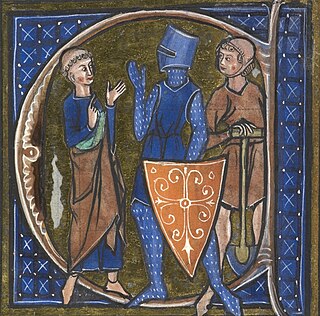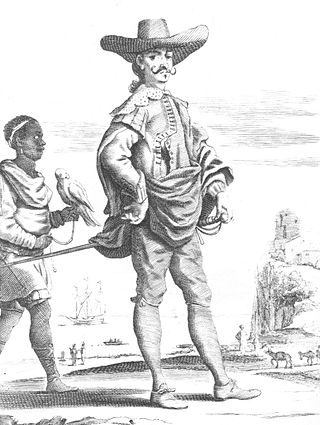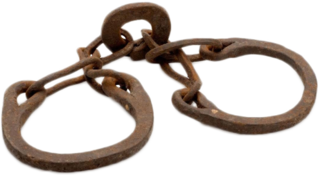
The szlachta were the noble estate of the realm in the Kingdom of Poland, the Grand Duchy of Lithuania, and the Polish–Lithuanian Commonwealth who, as a class, had the dominating position in the state, exercising extensive political rights and power. Szlachta as a class differed significantly from the feudal nobility of Western Europe. The estate was officially abolished in 1921 by the March Constitution.
The bourgeoisie is a social class, equivalent to the middle or upper class. They are distinguished from, and traditionally contrasted with, the proletariat by their affluence, and their great cultural and financial capital. They are sometimes divided into a petty, middle, large, upper, and ancient bourgeoisie and collectively designated as "the bourgeoisie".

The April Theses were a series of ten directives issued by the Bolshevik leader Vladimir Lenin upon his April 1917 return to Petrograd from his exile in Switzerland via Germany and Finland. The theses were mostly aimed at fellow Bolsheviks in Russia and returning to Russia from exile. He called for soviets, denounced liberals and social revolutionaries in the Provisional Government, called for Bolsheviks not to cooperate with the government, and called for new communist policies. The April Theses influenced the July Days and October Revolution in the next months and are identified with Leninism.

The estates of the realm, or three estates, were the broad orders of social hierarchy used in Christendom from the Middle Ages to early modern Europe. Different systems for dividing society members into estates developed and evolved over time.
There is significant disagreement among historians of the French Revolution as to its causes. Usually, they acknowledge the presence of several interlinked factors, but vary in the weight they attribute to each one. These factors include cultural changes, normally associated with the Enlightenment; social change and financial and economic difficulties; and the political actions of the involved parties. For centuries, the French society was divided into three estates or orders.

The modern social structure of France is complex, but generally similar to that of other European countries. Traditional social classes still have some presence, with a large bourgeoisie and especially petite bourgeoisie, and an unusually large proportion, for modern Europe, of farming smallholders. All these groups, and the remaining industrial working class, have considerable political power, which they are able to flex when required.

An hidalgo or a fidalgo is a member of the Spanish or Portuguese nobility; the feminine forms of the terms are hidalga, in Spanish, and fidalga, in Portuguese and Galician. In popular usage, the term hidalgo identifies a nobleman without a hereditary title. In practice, hidalgos were exempted from paying taxes, yet owned little real property.

Before the 1910 Mexican Revolution, most land in post-independence Mexico was owned by wealthy Mexicans and foreigners, with small holders and indigenous communities possessing little productive land. During the colonial era, the Spanish crown protected holdings of indigenous communities that were mostly engaged in subsistence agriculture to countervail the encomienda and repartimiento systems. In the 19th century, Mexican elites consolidated large landed estates (haciendas) in many parts of the country while small holders, many of whom were mixed-race mestizos, engaged with the commercial economy.

The Ancien Régime, also known as the Old Regime, was the political and social system of the Kingdom of France from the Late Middle Ages until 1789 and the French Revolution, which abolished the feudal system of the French nobility (1790) and hereditary monarchy (1792). The Valois dynasty ruled during the Ancien Régime up until 1589 and was then replaced by the Bourbon dynasty. The term is occasionally used to refer to the similar feudal systems of the time elsewhere in Europe such as that of Switzerland.

Burgher arms or bourgeois arms are coats of arms borne by persons of the burgher social class of Europe since the Middle Ages. By definition, however, the term is alien to British heraldry, which follows other rules.

Gentry are "well-born, genteel and well-bred people" of high social class, especially in the past. Gentry, in its widest connotation, refers to people of good social position connected to landed estates, upper levels of the clergy, and "gentle" families of long descent who in some cases never obtained the official right to bear a coat of arms. The gentry largely consisted of landowners who could live entirely from rental income, or at least had a country estate; some were gentleman farmers. In the United Kingdom, the term gentry refers to the landed gentry: the majority of the land-owning social class who typically had a coat of arms, but did not have a peerage. The adjective "patrician" describes in comparison other analogous traditional social elite strata based in cities, such as free cities of Italy, and the free imperial cities of Germany, Switzerland, and the Hanseatic League.
Social class in Italy began early on in Ancient Rome, and this article comprises more or less how it is today.

The medieval English saw their economy as comprising three groups – the clergy, who prayed; the knights, who fought; and the peasants, who worked the landtowns involved in international trade. Over the five centuries of the Middle Ages, the English economy would at first grow and then suffer an acute crisis, resulting in significant political and economic change. Despite economic dislocation in urban and extraction economies, including shifts in the holders of wealth and the location of these economies, the economic output of towns and mines developed and intensified over the period. By the end of the period, England had a weak government, by later standards, overseeing an economy dominated by rented farms controlled by gentry, and a thriving community of indigenous English merchants and corporations.

Nobility is a social class found in many societies that have an aristocracy. It is normally ranked immediately below royalty. Nobility has often been an estate of the realm with many exclusive functions and characteristics. The characteristics associated with nobility may constitute substantial advantages over or relative to non-nobles or simply formal functions, and vary by country and by era. Membership in the nobility, including rights and responsibilities, is typically hereditary and patrilineal.

The economics of English agriculture in the Middle Ages is the economic history of English agriculture from the Norman invasion in 1066, to the death of Henry VII in 1509. England's economy was fundamentally agricultural throughout the period, though even before the invasion the market economy was important to producers. Norman institutions, including serfdom, were superimposed on an existing system of open fields.

Like slavery, serfdom has a long history that dates to ancient times.

The working class comprises those engaged in manual-labour occupations or industrial work, who are remunerated via waged or salaried contracts. Working-class occupations include blue-collar jobs, and most pink-collar jobs. Members of the working class rely exclusively upon earnings from wage labour; thus, according to more inclusive definitions, the category can include almost all of the working population of industrialized economies, as well as those employed in the urban areas of non-industrialized economies or in the rural workforce.
The proletariat is the social class of wage-earners, those members of a society whose only possession of significant economic value is their labour power. A member of such a class is a proletarian. Marxist philosophy considers the proletariat to be exploited under capitalism, forced to accept meager wages in return for operating the means of production, which belong to the class of business owners, the bourgeoisie.
The croquant rebellions were several peasant revolts that erupted in Limousin, Quercy, and Perigord (France) and that extended through the southeast of the country in the latter part of the 16th and beginning of the 17th centuries.

Social class in Luxembourg after 1945 is generally based on occupation, personal income, and spending power as well as rights to social welfare rather than birth circumstances and family background. The country's demographic situation has changed considerably since 1945, where a mostly blue-collar working population gave way to mostly white-collar occupations over the second half of the twentieth century. Differences in consumer patterns between the white-collar and blue-collar workers decreased considerably between 1963 and 1977, causing a socio-economic evolution that saw a wider sphere of access for both working and middle classes to consumer goods such as cars, white goods, and real estate, thus demonstrating an equalisation of social strata in terms of income and spending power. The population of Luxembourg has also altered in nature due to significant growth in numbers of residents and increases in migration patterns since the mid-twentieth century; in 1961 13% of the population consisted of non-Luxembourgers, by 2020, this is at 44.3. At present, 47% of the Luxembourgish population has a migrant background’, and this is as a result of the response to socioeconomic processes that drew large numbers of immigrants to the country in the latter half of the twentieth century.












